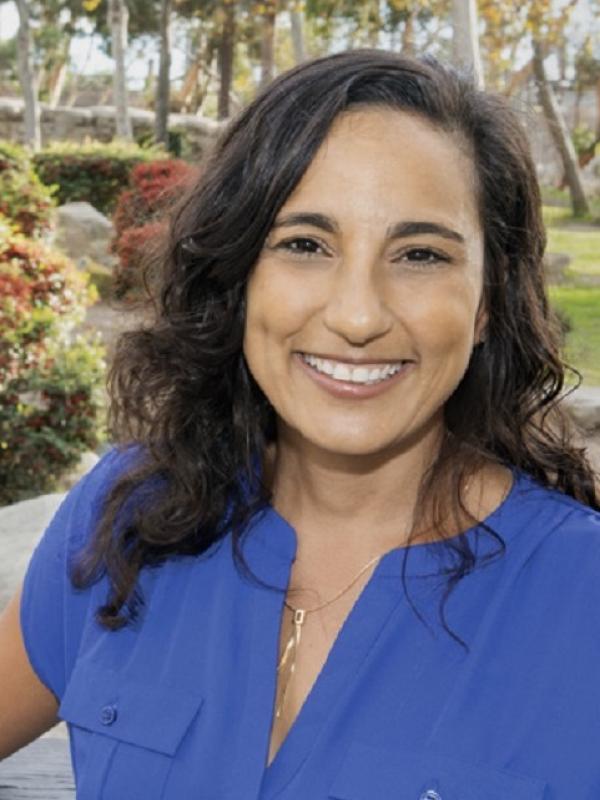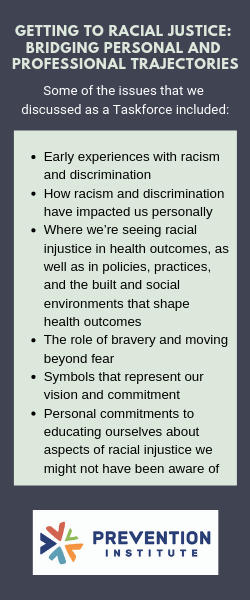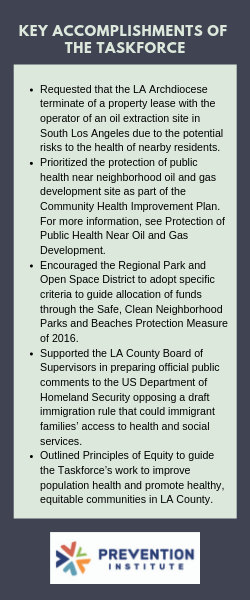 By Manal J. Aboelata, MPH, Deputy Executive Director, Prevention Institute
By Manal J. Aboelata, MPH, Deputy Executive Director, Prevention Institute
Across the country, local jurisdictions are employing a variety of tactics to achieve health equity and racial justice. In 2016, as Los Angeles County prepared to integrate the departments of mental health, public health, and health services under a single health agency umbrella, the Board of Supervisors recognized the value in creating an advisory body that would tap into the knowledge and expertise of community-based organizations and LA County residents to elevate priorities, challenges, and opportunities to eliminate gaps in public health outcomes through a focus on the determinants of health and wellbeing. This profile details the early days of the Taskforce, including its efforts to embed community-based health equity perspectives into county decision-making and center racial justice within its focus on health equity. It also outlines the critical role of the local public health department in supporting the Taskforce. The aim of this profile is to provide those in and outside of LA with a snapshot of this nascent effort and emergent lessons for those interested in addressing health equity and racial justice by forging stronger ties between local government decision-makers and diverse organizational and community-based interests. Though it’s too early to claim “success”, this profile sheds light on some of the formative experiences of the Taskforce to inform those interested in testing similar approaches elsewhere and provide background for those seeking to contribute to the effort underway in LA County.
How the Taskforce Came to Be
In May 2016, LA County’s Community Prevention and Population Health Taskforce met for the first time. Formed through an August 11, 2015 Board motion, the Taskforce’s charge was to advise the LA County Board of Supervisors on critical issues and opportunities to improve the health and wellbeing of LA County residents, with a focus on advancing health equity by influencing the structures and systems that generate the preconditions for healthy people in healthy neighborhoods. The Taskforce was formed by the same motion that created LA County’s Health Agency, an umbrella agency that would be asked to support and facilitate coordination across the departments of Public Health, Mental Health, and Health Services. Recognizing that most of the integration-planning efforts had focused on opportunities for service integration and care coordination, and that relatively little emphasis had been placed on identifying cross-departmental opportunities to advance population health, the Board amended their Health Agency motion to establish the Community Prevention and Population Health Taskforce.
Early on, in dialogue between the Health Agency director (who also held the position of director of the Department of Health Services) and the acting directors of Public Health and Mental Health, it was determined that the Public Health Department would provide staff support for the Taskforce. One advantage of this decision was that the Public Health Department recognized the importance of a focus on population health and had experience improving health outcomes through policy and systems change efforts. One potential downside to this decision was that it pulled the visibility and “co-ownership” of the Taskforce away from the agency level where it might have generated greater cross-departmental accountability for community- and population-level action. Nonetheless, the Public Health Department mission aligned well with the purview of the Taskforce and provided staff support that in many ways proved a “natural fit” for the work ahead.
Comprised of 25 representatives from across LA County’s five supervisorial districts, the Taskforce aimed to create a strategic venue for addressing social, economic, and political conditions impeding health equity. The Taskforce sought to accomplish this by influencing policy decisions and institutional practices that could systematically improve health and wellbeing for all LA County residents. For the Taskforce, this meant reducing resource and opportunity inequities between people of color, those underpaid and forced into poverty, and more affluent, white residents in the county, who disproportionately experience better health outcomes on a variety of measures.
Early Challenges
 Unlike a mature county commission with a clear vision, mission, charter, and bylaws, the new Taskforce had the formidable job of defining its core purpose, structure, and identity at the same time members were getting to know one another. Ultimately, the experience of the Taskforce shows that a newly formed group can forge a path forward, but this requires democratically-elected leadership, hard work, and commitment. The eventual decision to focus on racial equity as a key driver for achieving health equity did not come easily, and required much discussion, deliberation, and debate. At early Taskforce meetings, tensions ran high. Some members were confident and clear about the need to focus explicitly on racial equity. They noted that achieving the vision of health equity would not be possible without eliminating unjust and preventable gaps in health, observable by race. LA County data showed us persistent gaps, for instance, in infant mortality by race that could not be explained by genetics, behavior, or health insurance status. Others brought differing knowledge, expectations, and priorities. One member felt racial equity was “too political” for a health-focused group, others worried that a focus on racial equity would mean ignoring gender equity, linguistic equity, or other intersecting dimensions of social equity. Some members were not prepared to claim a central focus on racial equity within the broader health equity frame and this set the stage for hard but ultimately productive conversations.
Unlike a mature county commission with a clear vision, mission, charter, and bylaws, the new Taskforce had the formidable job of defining its core purpose, structure, and identity at the same time members were getting to know one another. Ultimately, the experience of the Taskforce shows that a newly formed group can forge a path forward, but this requires democratically-elected leadership, hard work, and commitment. The eventual decision to focus on racial equity as a key driver for achieving health equity did not come easily, and required much discussion, deliberation, and debate. At early Taskforce meetings, tensions ran high. Some members were confident and clear about the need to focus explicitly on racial equity. They noted that achieving the vision of health equity would not be possible without eliminating unjust and preventable gaps in health, observable by race. LA County data showed us persistent gaps, for instance, in infant mortality by race that could not be explained by genetics, behavior, or health insurance status. Others brought differing knowledge, expectations, and priorities. One member felt racial equity was “too political” for a health-focused group, others worried that a focus on racial equity would mean ignoring gender equity, linguistic equity, or other intersecting dimensions of social equity. Some members were not prepared to claim a central focus on racial equity within the broader health equity frame and this set the stage for hard but ultimately productive conversations.
Several key events were pivotal as the group simultaneously had the almost fracturing experience of getting to know one another while hashing out complex discussions on how and to what extent racial equity would become a central lens with which to explore issues and prioritize solutions. One of these inflection points came in the form of the Taskforce’s first meeting, which took place in the wake of the November 2016 election. An ad hoc workgroup had formed to gather input from the full Taskforce and report back with a proposed vision and approach. This workgroup represented a cross-section of the full Taskforce and met several times to outline a vision and rationale which proposed that the Taskforce focus on racial equity as a primary portal through which to address health inequities and highlight intersectionality with other forms of social and structural inequity. The Friday immediately following the election, the full membership walked into the meeting room, all grappling, in different ways, with the fact that Trump had just been elected president. For some, this result underscored the primacy of structural racism. For others, it foreshadowed an unacceptable rollback on religious tolerance, immigration policies, or gender equity. For some, Trump’s election meant all those things. When the ad hoc committee shared its presentation, members of the full group pushed back. One member later recalled this as the “worst meeting” she’d ever attended. Voices were raised, and differences of opinion and life experience were exposed. Though many people had had previous similar experiences where “getting to racism” was asked to take a backseat to dealing with other forms of inequity, the group pressed on, but by the time the meeting was set to end, no clear consensus had emerged about a obvious next step for the group. The Taskforce was not scheduled to meet again for three months. Would people just simmer in their own perspectives and feelings without time to process as a group? Was the solid effort of the ad hoc committee just going to be shelved? Would the members fundamentally committed to addressing racial justice as a pathway to achieving health equity stay with the process?
Support From the Field
After that meeting, the Taskforce chair and Public Health Department’s Office of Planning staff regrouped and strategized one-on-one with members of the full Taskforce to take stock of member perspectives. It became clear that people were committed to coming back to the table, though some had serious reservations. Others had experienced similar dynamics in other settings and offered advice on how to proceed, which led to a second inflection point in the group’s early days, in the form of outside support.
With resources from the Department of Public Health’s Office of Planning, which provides staff support to the Taskforce, they were able to engage the Center for Social Inclusion to conduct special training under the auspices of its work with GARE, the Government Alliance on Race and Equity, to help facilitate a dialogue among Taskforce members. As a result of this dialogue, group members agreed to come together two additional times before the next scheduled quarterly meeting, and the external facilitators helped the group develop ground rules for discussion and navigate some of the tough dynamics that had surfaced at the last meeting. For some members, the trainings reinforced what they were already deeply knowledgeable about: how racial inequities are produced and what can be done to address these inequities. Others found the data and information compelling but not necessarily sufficient to convince them that racial equity should take center stage for a “health group” meant to represent all the county’s 10,000,000+ residents across its 4700-square mile territory. To some, these outsiders focused on racial equity seemed like people paid to advance a racial equity agenda. Still, the group activities led to members talking together in pairs, sharing life experiences, and continuing the hard work of untangling personal and professional biases about the existence and impact of structural and systemic inequities on health.
The third key moment came in the form of the arrival of Dr. Barbara Ferrer, LA County’s newly appointed director of Public Health, who is both comfortable with and explicit about her intention to deal with racial justice and orient her department toward health equity. Her first formal remarks to the Taskforce underlined the centrality of achieving racial equity on the path toward health equity. She affirmed how “heartbreakingly difficult” it can be to discuss racial inequities and how they manifest in the county’s health outcomes, particularly for groups like indigenous and First Nations People, and African Americans, for instance. Her message to the group served as an invitation to do hard work worth doing, even as she said: there’s no roadmap.
Turning a Corner
 Neither the GARE training nor Dr. Ferrer‘s arrival to LA County could undo the political climate created by Trump’s election, nor did they erase the words that had revealed sharply divergent views on the role of racial justice in health equity, but these factors did advance the group sufficiently to keep most of the membership intact and pave the way for the Taskforce to create subgroups that would later develop: Principles of Equity; an official letter to the Archbishop of LA urging the Archdiocese to revoke its lease to an oil-drilling tenant operating in the middle of a densely populated Latino and African-American residential community; a position statement opposing the Trump administration’s proposal to bar immigrants from changing their residency status if they enrolled in public benefit programs; and, a memo to the Regional Parks and Open Space District emphasizing the importance of prioritizing investments of the county’s parcel tax dollars for parks and open space in the highest-need communities on the basis of documented park and health inequities.
Neither the GARE training nor Dr. Ferrer‘s arrival to LA County could undo the political climate created by Trump’s election, nor did they erase the words that had revealed sharply divergent views on the role of racial justice in health equity, but these factors did advance the group sufficiently to keep most of the membership intact and pave the way for the Taskforce to create subgroups that would later develop: Principles of Equity; an official letter to the Archbishop of LA urging the Archdiocese to revoke its lease to an oil-drilling tenant operating in the middle of a densely populated Latino and African-American residential community; a position statement opposing the Trump administration’s proposal to bar immigrants from changing their residency status if they enrolled in public benefit programs; and, a memo to the Regional Parks and Open Space District emphasizing the importance of prioritizing investments of the county’s parcel tax dollars for parks and open space in the highest-need communities on the basis of documented park and health inequities.
These actions, described in the Taskforce’s annual report to the board, raised the visibility of the Taskforce and recorded the Taskforce’s progress toward shared influence and advocacy. Taskforce members began to meet with their appointing supervisors, field questions from deputies about why “a health group” was weighing in on so-called “non-health issues,” bring pressing opportunities to Taskforce agendas, and hear from members of the public, all while strengthening and solidifying the Taskforce’s purpose and charter.
The Taskforce also formed a subcommittee to identify and address the health impacts and root causes of LA’s housing crisis, including issues like land-use practices and affordability. With strong leadership and participation from members both academically and practically knowledgeable about all aspects of the housing system, this subcommittee not only educated Taskforce members less familiar with the topic, but produced draft principles for a just and healthy housing system and advised the public health department on housing strategies for its five-year Community Health Improvement Plan (CHIP).
During its first two years, the Taskforce agreed to serve as the advisory body to the County Health Agency’s Center for Health Equity at the request of the Public Health director. The Center for Health Equity was initiated by Dr. Ferrer soon after her arrival to Los Angeles County. The Taskforce provided advice to the Public Health department as it was getting the Center up and running, and continues to provide guidance as it sets priorities, produces publications, and engages with other departments. The Taskforce also established an ad hoc committee to respond to a board motion on the formation of a county-wide Office of Violence Prevention. At a community forum on the health risks of oil and gas drilling, the Taskforce expressed support for the public health department’s report outlining opportunities for the City of LA to protect the health of residents exposed to the noise, vibration, and air-quality impacts of neighborhood oil and gas operations. Through collective action, the Taskforce generated momentum and took supportive actions on issues critical to Taskforce members and local residents. Perhaps as a signal of the value members derived from the Taskforce, many members sought reappointment at the end of their first two-year term and will provide continuity for the Taskforce as it welcomes and onboards new members with additional expertise and energy.
Moving Forward
At the beginning of its third year, the Taskforce sought to be even more effective and influential. The Center for Health Equity adopted the Taskforce’s Principles of Equity and agreed to work with other departments in the county to embed those principles in their own institutional practices. At a press event announcing the Center for Health Equity’s Action Plan, the Taskforce’s founding co-chair and the incoming co-chair elected to lead the second cohort of the Taskforce emphasized the importance of maintaining a clear commitment to closing gaps in health and safety for people of color and urged county supervisors to direct all county departments to demonstrate how their budgets and actions will support that goal.
On August 16, 2018, the second cohort of the Taskforce’s newly appointed and nominated members conducted its first public meeting in Long Beach at Century Villages at Cabrillo, a 27-acre campus community offering permanent supportive and affording affordable housing, along with comprehensive resources and supports to formerly homeless people, including a nature walking path, garden, community center, and federally-qualified community health center. A Taskforce member selected the meeting location, reflecting the Taskforce’s practice of rotating meetings to different parts of LA County, with the intent of showcasing the county’s diversity and increasing public access to the Taskforce across LA County’s vast geography.
For a group that meets for about three hours every quarter and whose primary resources are the time of its dedicated members and the support it receives from the Department of Public Health, the Taskforce has done a remarkable job establishing itself as a county node of activism for addressing the structural and systemic drivers of health inequities. Over the coming two years, the Taskforce, now an official county commission at the behest of the Board, is poised to elevate community prevention and population health in LA County to new heights.
Though it is still too early to claim the success of the Taskforce, some early indicators suggest that it is filling an important need in LA County. Diverse members have weighed in supportively on policy priorities that they may not have previously been activated around; the Board of Supervisors has recognized the Taskforce for bringing a unique and added-value perspective to the county’s priority-setting; and the Health Agency and the Public Health Department have tapped the expertise of the Taskforce and acted on priorities elevated by the Taskforce.
Looking Ahead
Up until 2016, LA County Board of Supervisors had no designated group working to tackle health equity issues from a community-oriented public health and social justice perspective. Now, with the ongoing support of the Board, the Public Health Department’s director, the Office of Planning, the director of the Center for Health Equity, and, critically, the deep commitment of highly strategic and effective members, LA County’s Community Prevention and Population Health Taskforce can serve as a place to center issues of racial justice as a focus of efforts to achieve health equity, hear the public’s concerns, and make recommendations that will help move LA County toward becoming a leader in community prevention and population health. The fact that the Board of Supervisors recognized and acted to fill this gap signals that top-level leadership in the county is committed to elevating community prevention, improving population health, and eliminating inequitable gaps in health and wellbeing.
It is worth noting that the Taskforce was not alone in its struggle to determine whether and how to acknowledge the centrality of racial justice in its efforts. The Department of Public Health and the Health Agency were also engaged in similar conversations and learning journeys. As the Taskforce forges ahead, it can play a key leadership role in LA County. Relying on its membership, its position with respect to the Board of Supervisors, and its relative agility, the Taskforce can demonstrate its vision for Los Angeles County and provide both guidance and pressure as larger government entities move toward assuming leadership in this arena.
While still in its early days, the Taskforce and the county government are working together to demonstrate that intentional and proactive steps can and should be taken to eliminate persistent health inequities, so that all people have the resources and opportunities they need to thrive and live long healthy lives. One of the lessons from the early experience of the Taskforce is that having conversations about how to do things differently to achieve racial justice and health equity are hard. Another takeaway is that people are all in different places on their personal and professional journeys. As the work of the Taskforce continues and membership evolves, it also becomes clear that these aren’t just conversations you can have and “be done.” The practice of embedding racial justice and health equity into priority-setting and decision-making requires constant creativity, ongoing vigilance, and improvement in everyone’s skills and capacities. There is still much work that lies ahead, and the Taskforce remains motivated to offer a venue that draws on the strength of many to add urgency and deeper “community voice” into the development of priorities and implementation of strategies that will improve conditions and increase opportunities that impact health and wellbeing in LA neighborhoods. It’s clear from the Taskforce’s early and ongoing experiences that there is no roadmap for bridging health equity and racial justice, but to achieve health and dignity for all, it’s a path worth travelling together.
About the author: Manal J. Aboelata, MPH is deputy executive director at Prevention Institute. Manal’s oral testimony to the LA County Board of Supervisors was the basis for the amendment to the Board motion that formed the Community Prevention and Population Health Taskforce. Manal was appointed to represent the Second Supervisorial District (South Los Angeles, Supervisor Mark Ridley-Thomas) on the Taskforce and was subsequently voted by her peers to serve as the Taskforce ‘s first chairperson. Manal is currently an LA County Commissioner and continues to represent the 2nd Supervisorial District as a member of the Taskforce. While Manal made every effort to present an accurate and nuanced picture of the Taskforce’s history and trajectory, she accepts full responsibility for any errors or omissions.
Acknowledgement: Manal would like to thank everyone who took the time to review this snapshot and provide their thoughtful input including Barbara Ferrer, PhD, MPH, MEd. Director, Los Angeles County Department of Public Health, Megan McClaire, MSPH. Chief of Staff, Los Angeles County Department of Public Health, Gayle Haberman, MPH. Director of the Office of Planning, Evaluation and Development, Los Angeles County Department of Public Health, Nancy Halpern Ibrahim, MPH. Executive Director, Esperanza Community Housing and Taskforce Member, Jim Mangia, President and CEO, St. John’s Well Child and Family Center and Taskforce Member, Richard Hofrichter, PhD. Senior Director, Health Equity at National Association of County and City Health Officials (NACCHO), Elva Yanez, MS, Director of Health Equity, Prevention Institute, La’Quana Williams, MPH. Associate Program Manager, Prevention Institute, Andrea Buffa, Director of Communications, Prevention Institute and Sarah Mittermaier, Communications Specialist, Prevention Institute for skillful editing.



